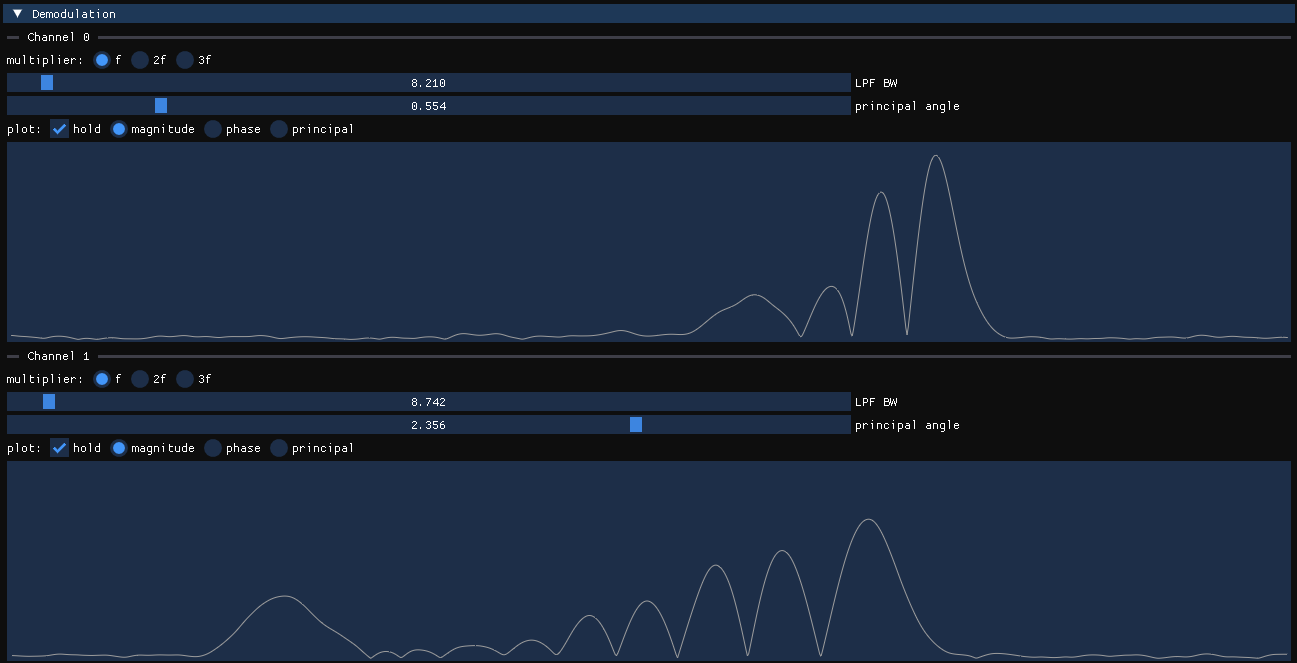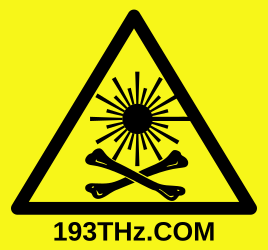

January 2025
The availability of computer audio interfaces with high performance and low cost makes it interesting to explore their use in DSP lock-in amplification, laser spectroscopy, and laser stabilization applications. For example, the Behringer UMC202HD comes with full-duplex 2x2 192kHz "24-bit" data converters and costs just about $110. And audio interfaces with many more channels are also available at very moderate prices.
This article describes the simultaneous spectroscopic locking of two diode lasers on a single lanthanum hollow cathode lamp, using the 1389.4nm and 1409.6nm lines of the doubly ionized species. These spectral lines are conveniently aligned with the ITU CWDM grid and therefore completely eliminate the requirement for academia's favorite temperamental, low-performance, and expensive lasers. The lasers are installed in Sinara Kirdy diode drivers, which are somewhat overkill for this experiment but very convenient to use.
The sound card is connected through a 480Mbps USB isolator based on the ADuM3165 - these are very cheap nowadays and are a convenient way to eliminate ground loops and their induced noise, in particular while probing the circuit with an oscilloscope. Audio transformers pick up substantial electromagnetic noise (at least in the hostile RF environment of my Hong Kong harbour view lab) and because of that problem constitute an inferior solution.
The output of the sound card is used to modulate the current of Box Optronics CWDM DFB lasers through the LF MOD input of Kirdy, on the highest gain setting of 25mA/V. The noise in the sound card's output is reduced using a low-pass filter made with a 470 ohm resistor and a 100nF capacitor (3.4kHz bandwidth) - outside the audible range, the sound card has quite some broadband noise plus a peak around 150kHz, and another smaller peak is added around 200kHz by the USB isolator's DC-DC converter. All this noise is effectively attenuated by that simple RC filter. Additionally, two 1N4148 diodes with opposite polarities are connected in parallel with the LF MOD input, whose function is to clamp the voltage and protect the laser diode in case something goes wrong with the sound card.
The P827A hollow cathode lamp is powered through a 10k ballast resistor and operated around its maximum current rating of 30mA, which corresponds to an applied voltage of 430V. Higher current improves the signal to noise ratio, but reduces the lamp's lifetime. The ballast resistor has to dissipate 9W and was made using a parallel/series combination of four 5W 10k ceramic wirewound resistors. The lamp is then AC coupled into a AD620-based amplifier through a high-voltage 200nF capacitor with a 47k series resistor. The 47k resistor is very important to limit the current to intensities that the AD620's protection diodes can handle during transients (turn-on, lamp strike, turn-off), and it must be rated for high voltage. Additionally, a 1M resistor must be added between the AD620 input and ground, otherwise charge accumulates at this point which easily reaches a DC voltage that saturates the AD620. It can be placed after the 47k resistor so it does not have to handle the high voltage.
The AD620 was part of the low-cost "AD620 microvolt/millivolt voltage amplifier module" available from several Aliexpress vendors. See the schematics here. The major flaw of this module is the ripple from the charge pump circuit around U1 couples through R3/R7 into the REF pin of the AD620, and dominates the output noise. To alleviate this problem, I have cut the negative power supply rail under the PCB to insert a series SMD 100 ohm resistor and soldered a 100µF electrolytic capacitor on top of one of the existing ceramic decoupling capacitors for that rail. Additionally, I connected a 10µF ceramic capacitor between the cursor of R7 and ground. With these modifications, the output noise becomes a lot more reasonable. The module can then be mounted together with the other electronic components near the base of the hollow cathode lamp, to minimize the cabling length that carries signals at high impedance and is therefore more sensitive to electromagnetic pollution.
There are probably better ways to do this, in particular to avoid the high power dissipation in the ballast resistor, but this will be for later.
The optical setup was much simplified compared to the one described in the article from two years ago, and consists only of the fiber collimator shooting the laser beam directly into the lamp, without steering mirrors. The alignment is actually fairly easy: to maximize the laser-plasma interaction it is sufficient (and necessary) to have the entirety of the laser spot hit the back surface of the lamp's hollow cathode. This can be done simply by fiddling with the optical mounts manually (mediocre CDHOptics/Daheng mounts which I had purchased before discovering Oeabt), micrometer screws or anything fancy are not necessary.
The DSP software modulates the laser by generating a sine wave using DDS, performs lock-in amplification perfectly tuned to the DDS by using the same frequency tuning word, and plots the results in real-time using ImGui. It was written for OpenBSD using the sndio API, as a previous experience with Linux's ALSA had left me somewhat skeptical of its ability to reliably operate the sound card at 192kHz 24-bit 2x2 full-duplex.
In contrast to more primitive lock-in laser spectroscopy schemes that use a mechanical optical chopper, the diode current modulation applied does not turn the laser on and off but rather imprints a small variation of its optical frequency (in addition to unwanted amplitude modulation), as shown in the article FM spectroscopy of hydrogen cyanide via DWDM laser diode chirp. Combined with a DSP lock-in amplifier's straightforward ability to perform in-phase/quadrature (complex) demodulation, this gives real-time information about where the laser's frequency lies within the spectral line and enables locking the laser anywhere within that line, including at the top.
With this new rig, observing the La III hyperfine structure at 1389.4nm and 1409.6nm becomes a piece of cake:
It is possible to get even higher signal to noise ratios by playing with the modulation depth, LPF bandwidth and scan speed, but I am only interested in a proof of concept for the time being.
I was even able to observe the spectra using the low-cost Chinese hollow cathode lamp which did not work in the similar experiment two years ago. But the signal to noise ratio is a lot worse, though all the La III hyperfine features became clearly visible while operating the lamp at 32mA, i.e. at twice its maximum current rating of 16mA. Amusingly, when the lamp is maltreated in this way, the iron (Fe I) line at 1409.9nm also becomes visible, likely from the electrode material being vaporized :)
Since telecom laser diodes are intrinsically quite stable when driven by a low-noise current source like Kirdy, they can be locked to the spectral line with a simple software control loop that feeds back on the diode temperature using the TEC, despite the limited loop bandwidth of the entire system (due to sound card latency, USB latency, lock-in amplifier bandwidth reduction, network latency to Kirdy, and thermal lag).
Additionally, by modulating the two lasers at frequencies that are not multiples of each other, combining them with a standard low-cost WDM fiber coupler for 1390nm/1410nm, and keeping their power low enough to avoid saturating the HCL (inexpensive telecom diodes cannot really do that anyway), the simultaneous lock of two lasers on one lamp can be demonstrated. Note the servo's response (TEC temperature plot, bottom left on the Kirdy control panels) to the manually applied LD current steps (top right plot). See here for a photo of the shockingly simple hardware setup.
Laser-cooled La2+ ion traps are not practical due to low-performance and/or silly expensive NIR cameras combined with the low photon scattering rates of the ion. Academic labs have more patience and more money than me for this sort of thing. The present experiment successfully demonstrates a scheme for ultra-low-cost frequency stabilization of a pair of diode lasers to ion spectral lines; it was done with La2+ so I did not have to fiddle with the laser diodes to keep them single-frequency at the same time. The next step is to replicate this at 493nm/650nm where the luxury of inexpensive and high-quality DFB lasers is not available, but where free-running Fabry-Perot diodes nevertheless show promising results. This would enable the construction of a low-cost, compact, and vibration-insensitive laser system for a laser-cooled Ba+ ion trap.
> Ultra-low-cost stabilized laser system towards Ba+ Doppler cooling
< Table of Contents